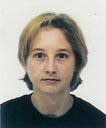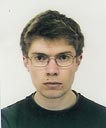|
People
|
Work Description
|
|
Giuseppe SALAMANNA
|
For my Ph.D. thesis i am going to work on B_s analyses within the CDFII experiment held in Fermilab. It is a multi-purpose experiment at the p-bar(p) accelerator Tevatron running at an energy 1.96 TeV in the c.o.m. I am involved in developing an efficient flavour tagging system in order to be able to perform competitive mixing and CP asymmetry measurements. In part., i am interested in kaon tagging both in the Same Side and in the Opposite Side. Related to this is my work on the CDF Time of Flight detector, including reconstruction and calibration analysis to perform pion/kaon identification. |
|
Roberto SALERNO
|
For my Ph.D thesis I am working on CMS, one of the four detectors that will operate at LHC p-p collider at CERN. I have performed analysis of data collected the last summer during a test beam over a module of four hundred crystals of the electromagnetic calorimeter (ECAL) of CMS. In this analysis I've calculated the different respose of crystals and APDs at temperature variation and their contribution at the energetic resolution of ECAL. Now I'm working in ORCA software event reconstruction toolkit, on calibration of ECAL with isolated electrons produced by the decay of the W bosons. |
|
Andreas SALZBURGER
|
I am a participant of the Austrian Doctoral Student program at CERN. For my PhD I am working on a preparation study of a high precision W mass measurement for the ATLAS experiment, one of four Large Hadron Collider (LHC) experiments. The determination of the total energy scale for leptons in the ATLAS detector is a crucial ingredient for a future W mass measurement. In this scope I am developing an extrapolation package for the track reconstruction that takes the propagation in an inhomogeneous magnetic field and multiple scattering respectively energy loss effects into account. In addition I have been working on the validation of the ATLAS Inner Detector full simulation based on the new simulation engine GEANT4. And I have also studied the effects on the ATLAS silicon detectors in case of a beam accident that may be caused by a wrong configuration of beam injection magnets. |
|
Roberto SANTORELLI
|
I am involved in the ICARUS experiment for my Phd thesis. The Technology of ICARUS is based on a liquid Argon TPC (Time Projection Chamber) detector in order to realize a detector of great mass (3000 tons) to study rare astroparticle events like interactions of artificial (beam of long band CNGS from CERN), solar, atmospheric and supernova's neutinos, together with the search for the decay of the proton and the detection of Dark Matter. The goal is the realization of a modular detector of 3000 tons of mass to place into the National Laboratories of the Gran Sasso (Italy). In order to study the possibility to perform a search for WIMPs, I am working on the development of a detector that uses liquid Argon as active material. |
|
Francesca SARRI
|
ATLAS is one of the four detectors now under construction at the pp Large Hadron Collider at CERN. The Pisa ATLAS group, in which I am working for my Ph.D. thesis, is involved in the construction and testing of the central hadronic calorimeter (TileCal). The energy calibration and equalization has been studied in a four years long test beam program. I have partecipated to these data takings and in particular I have been responsible of part of the online analysis which allowed to asses data quality. For my thesis I have studied the response of the calorimeter to different types of calibration events in order to understand the response of the readout electronics near and beyond its saturation. These studies allow to recover partially the linearity beyond the electronics saturation, thus enlarging the sensitivity of the detector to physics effects that can be revealed through very energetic jets, such as the fermionic compositeness. Just recently I have started a study to compare the test beam data to the G4 detector simulation. |
|
Jan SCHUMACHER
|
My Ph.D. thesis is beeing prepared in the context of the ATLAS experiment. ATLAS is one of the multi-purpose detectors at LHC. Presently I am working on programming the pixel ROD (Read Out Driver) which is a component of the off-detector electronics. Its task is to control, calibrate and readout individual modules of the ATLAS pixel detector. In particular, I am working on software to control and test the modules through the ROD for a system test. The finished product will allow an expert to control several modules connected to one or more RODs. Beginning later this year I will be doing increasingly more work on Higgs production through vector boson fusion. As of yet, this has not been analysed for the high luminosity case. |
|
Jadranka SEKARIC
|
I am doing my Ph.D on LC project TESLA (e-gamma and gamma-gamma options), more exactly trilinear gauge couplings at photon collider within strong EWSB. The work is based on Monte Carlo simulations of e-gamma -> W nu, which could be used for any future photon collider. Also, my work contains the background studies in TPC and vertex detector in order to design the forward region of the detector with minimal background coming from pair creation. |
|
Cedric SERFON
|
For my PhD thesis I'm working on ATLAS, one of the four experiences which will operate at the futur Large Hadron Collider at CERN. My work is more especially related to the electromagnetic end-cap calorimeter (EMEC) of ATLAS. In a first time, I've analysed the test-beam data taken for 3 modules of the EMEC and studied the uniformity (using 120 GeV electrons runs) and energy resolution. An other part of my work is to provide some analysis tools to make electron-jets separation, in order to reach the expectations of ATLAS (jets rejection factor of about 100000 for an electron efficiency of about 70%). |
|
Mariya SHIYAKOVA
|
I am working on ATLAS experiment. The ATLAS is one of four general- detectors which would be operational at the start-up of the LHC (Large Hadron p+p+ Collider) in order to exploit its full discovery potential. The work is consisting on full simulation and reconstruction the process Higgs decay to 4 muons with various range of mass. The LHC offers a large range of physics opportunities, among which the origin of mass at the electroweak scale is a major focus of interest. The detector optimization is therefore guided by physics issues such as sensitivity to the largest possible Higgs mass range. This work includes the study and development of software and tools of physics analysis. |
|
Mark SLATER
|
I am currently working towards a PhD on NA48 at CERN. This is a fixed target experiment studying various aspects of Kaon physics and CP violation, with my particular analysis being the first measurement of the branching ratio for the decay Ks->pi0 mu+ mu-. As this is a very rare decay, (predicted branching ratio ~10^-10), a very good understanding of the background processes was required. I have done extensive studies of both data and Monte Carlo so the cuts could be refined to give an acceptable level of background. I have also needed to understand both hardware and software triggers in the experiment so an accurate trigger efficiency could be measured. |
|
Alexey SOKOLOV
|
For my thesis I'm working on ALICE, one of four giant detectors which will operate at Large Hardron Collider under construction at CERN. I'm developing an infrared laser test setup for the mass production tests of Silicon Strip Detectors, that will form two outmost layers of the ALICE Inner Tracker. The short fine-spot laser beam pulse crossing the detector plane can mimic a passage of charged particle, hence scanning the SSD module with such a beam will reveal all the unbonded strips and dead channels. To fully understand the constraints and advantages of the method I will compare the laser scan results with beamtest data obtained with first four SSD modules. For this beamtest performed in autumn 2003 at PS accellerator at CERN I wrote the aquisition and on-line reconstruction software. |
|
Elena SOLFAROLI CAMILLOCCI
|
For my Ph.D. thesis I am working on ATLAS, one of the detectors will operate at the LHC collider at CERN. In particular, I am interested in the muon spectrometer. In the past, I have performed a study on the performance of the Muon Drift Chamber, which will be employed as tracker in the spectrometer. Now my interest is turned to the study of the trigger chamber: the Resistive Plate Chamber. I am working on the simulation of the primary ionization and the avalanche generated in the chamber when a muon cross it. Moreover, I am studying the detector performance by analysing the data collected during the beam test on the RPC. |
|
Wolfram STILLER
|
It is the goal of my Ph.D. thesis to develop and test reliable calibration algorithms for the drift-tube muon-chambers of the muon spectrometer of the ATLAS detector. Testbeam data have been collected with a muon chamber in a 100 GeV muon beam. The chamber was irradiated at different photon rates to simulate the background conditions at the LHC up to a safety factor of 10. Currently I am developing and testing autocalibration algorithms with the data collected, focussing on achievable precision, reliability, and speed of the different methods in dependence of the irradiation rate and of the statistics used. For the second part of my Ph.D. research the analysis of a Higgs decay into b-bbar is foreseen. |
|
James STOREY
|
For my Ph.D thesis I am working on the LHCb experiment, one of the four detectors of the LHC accelerator. My work to date has been concerned with the Rich Imaging Cherenkov (RICH) sub-detectors. I am presently analysing testbeam data from tests of multianode photomultiplier (MAPMT) tubes. I have also worked on the development of the level-1 readout electronics. My future work will concern the feasibility of measuring the CP violating weak phase gamma from the decay LAMB -> LAM D0(-> K- PI+, K- PI+ PI+ PI-). |
|
Juraj SUTIAK
|
I am currently working on eRHIC. It is a future project of electron-proton collider experiment. It is planned that existing proton and heavy ion accelerator RHIC at BNL will be complemented by a 10GeV electron ring. The experiment will focus on low x and low Q squared measurements in the phase-space regions not reachable by experiments on HERA collider at DESY. I am working on detector optimization and performance studies. For this I use GEANT simulations. Our group is also involved in ZEUS experiment at DESY. Later I plan to participate on the analysis of the new ZEUS data. |
Catherine Cart 02/2004














